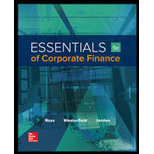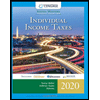
To determine: Whether the policy is worth purchasing.
Introduction:
The
Answer to Problem 60QP
The policy is not worth purchasing.
Explanation of Solution
Given information:
An insurance company offers a new policy to their customers. The children’s parents or grandparents will buy the policy at the time of the child’s birth. The parents can make 6 payments to the insurance company. The six payments are as follows:
- On the 1st birthday, the payment amount is $800.
- On the 2nd birthday, the payment amount is $800.
- On the 3rd birthday, the payment amount is $900.
- On the 4th birthday, the payment amount is $900.
- On the 5th birthday, the payment amount is $1000.
- On the 6th birthday, the payment amount is $1000.
After the 6th birthday of the child, the payment will not be made. At the time when the child is 65 years, he or she gets $150,000. The interest rate for the first 6 years is 9% and for the rest of the years is 5.5%.
Note: From the given information, it is essential to compute the future value of the premiums for the comparisons of the promised cash payments at 65 years. Thus, it is necessary to determine the premiums’ value at 6 years first, as the rate of interest varies at that time.
Time line of the payments:

Formula to calculate the future value is as follows:
Note: PV denotes the
Compute the future value for the five years is as follows:
Hence, the future value of 1st year is $1,230.90.
Hence, the future value of 2nd year is $1,129.27.
Hence, the future value of 3rd year is $1,165.53.
Hence, the future value of 4th year is $1,069.29.
Hence, the future value of 5th year is $1,090.
Compute the value of 6th year is as follows:
Note: The value of 6th year is calculated by adding all the computed future values and the 6th year’s value, that is, $1,000.
Hence, the value of 6th year is $6,684.98.
Compute the future value of the lump sum at the 65th birthday of the child is as follows:
Note: The number of years is 59, because after the 6th birthday of the child the payments will not be paid.
Hence, the future value of the lump sum at the 65th birthday of the child is $157,396.57.
From the above calculation of the future value, it can be stated that the policy is not worth purchasing as the deposit’s value in the future is $157,396.57, but the contract will pay off at $150,000. The premium’s amount to $7,396.57 is more than the payoff of the policy.
Note: The present value of the two cash flows can be compared.
Formula to calculate the present value of the premiums is as follows:
Compute the present value of the premiums as follows:
Hence, the present value of the premiums is $3,986.04.
The today’s value of the $150,000 at the age of 65 is as follows:
The cash flow of the premiums is still higher. At the time of zero, the difference is $187.32
Want to see more full solutions like this?
Chapter 5 Solutions
ESSENTIALS CORPORATE FINANCE + CNCT A.
- High Hand Nursery has total assests of $900,000, current liabilities of $202,000, and long-term liabilities of $104,000. There is $90,000 in preferred stock outstanding. Twenty thousand shares of common stock have been issued. a. Compute book value (net worth) per share. b. If there is $40,000 in earnings available to common stockholders for dividends, and the firm's stock has a P/E of 22 times earnings per share, what is the current price of the stock? c. What is the ratio of market value per share to book value per share?arrow_forwardNeed the WACC % WACC and Optimal Capital Structure F. Pierce Products Inc. is considering changing its capital structure. F. Pierce currently has no debt and no preferred stock, but it would like to add some debt to take advantage of the tax shield. Its investment banker has indicated that the pre-tax cost of debt under various possible capital structures would be as follows: Market Debt-to-Value Ratio (wd) Market Equity-to-Value Ratio (ws) Market Debt-toEquity Ratio (D/S) Before-Tax Cost ofDebt (rd) 0.0 1.0 0.00 6.0 % 0.10 0.90 0.1111 6.4 0.20 0.80 0.2500 7.0 0.30 0.70 0.4286 8.2 0.40 0.60 0.6667 10.0 F. Pierce uses the CAPM to estimate its cost of common equity, rs, and at the time of the analaysis the risk-free rate is 5%, the market risk premium is 7%, and the company's tax rate is 25%. F. Pierce estimates that its beta now (which is "unlevered" because it currently has no debt) is 1.4. Based on this information, what…arrow_forwardNed's Co. has an average collection period of 45 days and an operating cycle of 130 days. It has a policy of keeping at least $10 on hand as a minimum cash balance, and has a beginning cash balance for the first quarter of $20. Beginning receivables for the quarter amount to $35. Sales for the first and second quarters are expected to be $110 and $125, respectively, while purchases amount to 80% of the next quarter's forecast sales. The accounts payable period is 90 days. What are the cash disbursements for the first quarter? Question 4 options: $92 $88 $76 $100 $110arrow_forward
- Liberal credit terms for customers is associated with a restrictive short-term financial policy. Question 3 options: True Falsearrow_forwardAn accounts payable period decrease would increase the length of a firm's cash cycle. Consider each in isolation. Question 6 options: True Falsearrow_forwardWhich of the following is the best definition of cash budget? Question 10 options: Costs that rise with increases in the level of investment in current assets. A forecast of cash receipts and disbursements for the next planning period. A secured short-term loan that involves either the assignment or factoring of the receivable. The time between sale of inventory and collection of the receivable. The time between receipt of inventory and payment for it.arrow_forward
- Short-term financial decisions are typically defined to include cash inflows and outflows that occur within __ year(s) or less. Question 9 options: Four Two Three Five Onearrow_forwardA national firm has sales of $575,000 and cost of goods sold of $368,000. At the beginning of the year, the inventory was $42,000. At the end of the year, the inventory balance was $45,000. What is the inventory turnover rate? Question 8 options: 8.46 times 13.22 times 43.14 times 12.78 times 28.56 timesarrow_forwardThe formula (Cash cycle + accounts payable period) correctly defines the operating cycle. Question 7 options: False Truearrow_forward
- An accounts payable period decrease would increase the length of a firm's cash cycle. Consider each in isolation. Question 6 options: True Falsearrow_forwardWhich of the following issues is/are NOT considered a part of short-term finance? Question 5 options: The amount of credit that should be extended to customers The firm determining whether to issue commercial paper or obtain a bank loan The amount of the firms current income that should be paid out as dividends The amount the firm should borrow short-term A reasonable level of cash for the firm to maintainarrow_forwardLiberal credit terms for customers is associated with a restrictive short-term financial policy. Question 3 options: True Falsearrow_forward
 Intermediate Accounting: Reporting And AnalysisAccountingISBN:9781337788281Author:James M. Wahlen, Jefferson P. Jones, Donald PagachPublisher:Cengage Learning
Intermediate Accounting: Reporting And AnalysisAccountingISBN:9781337788281Author:James M. Wahlen, Jefferson P. Jones, Donald PagachPublisher:Cengage Learning Individual Income TaxesAccountingISBN:9780357109731Author:HoffmanPublisher:CENGAGE LEARNING - CONSIGNMENT
Individual Income TaxesAccountingISBN:9780357109731Author:HoffmanPublisher:CENGAGE LEARNING - CONSIGNMENT College Accounting, Chapters 1-27AccountingISBN:9781337794756Author:HEINTZ, James A.Publisher:Cengage Learning,
College Accounting, Chapters 1-27AccountingISBN:9781337794756Author:HEINTZ, James A.Publisher:Cengage Learning,




